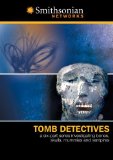The whole trick to watching the new educational series from the Smithsonian Channel is to keep your head. Someone once said that was the key to battle, to keep your head while those around you are losing theirs. Well, it appears a ton of folks have been losing their heads for centuries. On the surface Tomb Detectives is a real life Bones. The half hour episodes explore ancient bodies, usually merely skeletal remains, and attempt to answer some basic questions: How did they die? What was their life like? What kind of cultural traditions might have been involved with the death? Was this an execution or an inevitable result of battle? Where these ancient victims the willing participants in a religious sacrifice, or were there criminal elements at play? The series gives you a close up look at these remains and then introduces you to a team of scientists who will attempt to answer these burning questions. It’s sort of like the team from CSI trying to solve murders that are as much as 2000 or more years old. Of course, there is no statute of limitations on murder. We follow the team into the lab where various experiments provide clues to these answers. There are often very low budget dramatizations of the various theories the scientists come up with. The first two stories deal exclusively with ancient beheadings, and the theme pops up pretty consistently throughout the rest of the series. Someone has a serious head fetish here.
The episodes pretty much play out as your standard cable documentary with a bit more drama added on for effect. As we are introduced to each scientist there’s a freeze screen and an X-Files scroll that tells us who they are and what their specialty happens to be. Unfortunately, even in 26 minutes there is a ton of repetition in these shows. We see the same dramatization scenes over and over. There’s a lot of dry in the lab talk that might put you to sleep if the images themselves weren’t enough of an eye-opener. The show attempts to delve into a little history surrounding the discoveries in an attempt to put the find into some historical perspective. The narration, however, tends to point out the obvious and isn’t incredibly entertaining. In the end it’s a matter of seen one, seen them all kind of a thing. Your best bet is to try and catch the episodes on rerun at the Smithsonian Channel.
Video
Each episode is presented in its original television full frame format. It’s a documentary, and image quality is not a priority. Many of the “dramatic” effects tend to blur the image, so there isn’t a lot to love here. This does not appear to have been intended for high definition television and looks pretty much like a 15 year old Biography episode.
Audio
The Dolby Digital 2.0 track offers pretty much dialog and minimal music or effects. It’s fine for what it is.
Special Features
Nothing.
Final Thoughts:
I tend to enjoy historical things and for years considered actually buying a mummy to display in my house. I used to spend hours looking at the mummy at the Reading Museum when I was a kid. That fascination remains, so I was quite surprised at how quickly I was bored with these short episodes. It’s all pretty dry, and while the discoveries are actually quite interesting the presentation is pretty tedious. The show tries to put a very narrow spin on the evidence they examine and tends to make the facts fit their rather simple explanations. “I don’t think things are as straightforward as that.”




